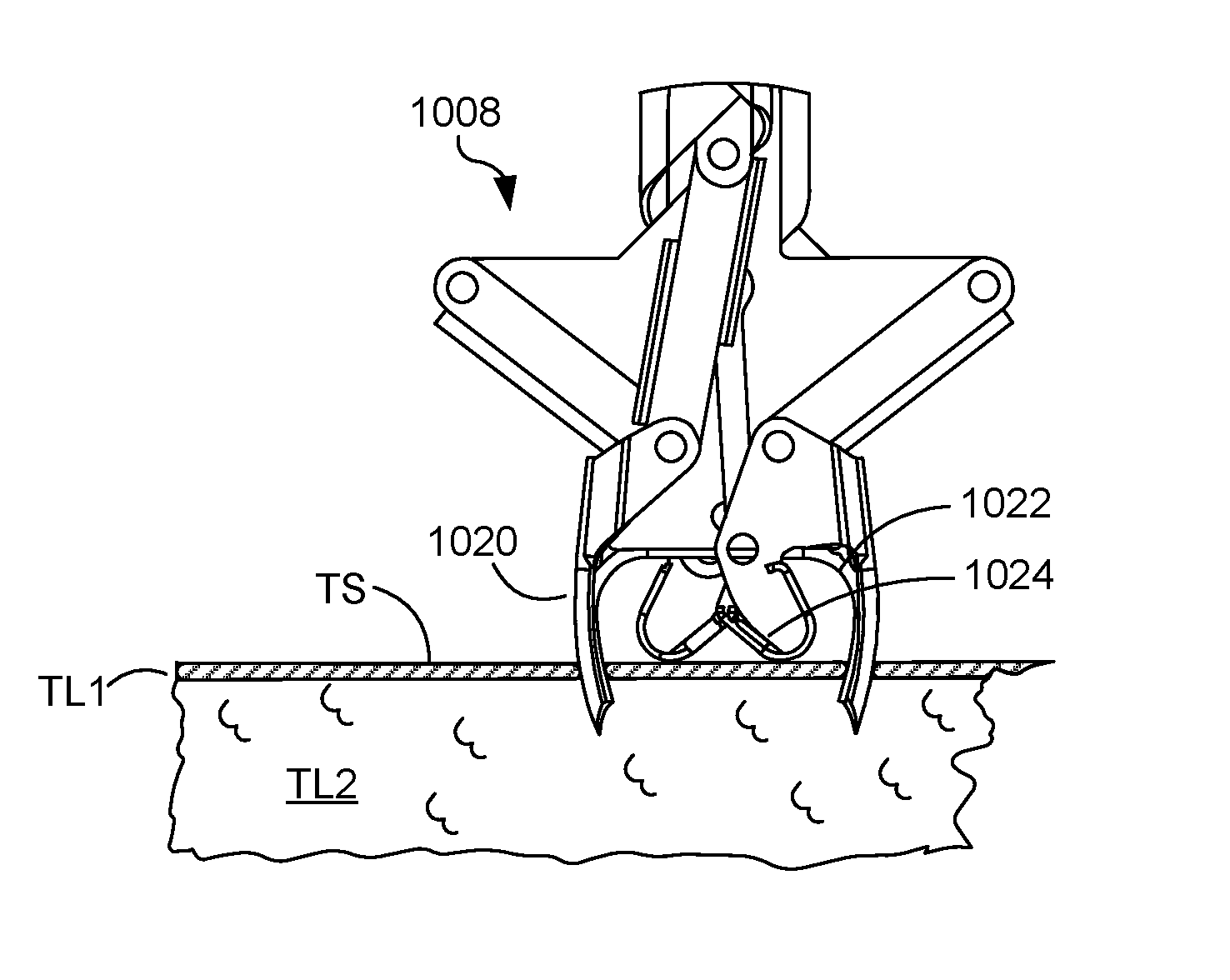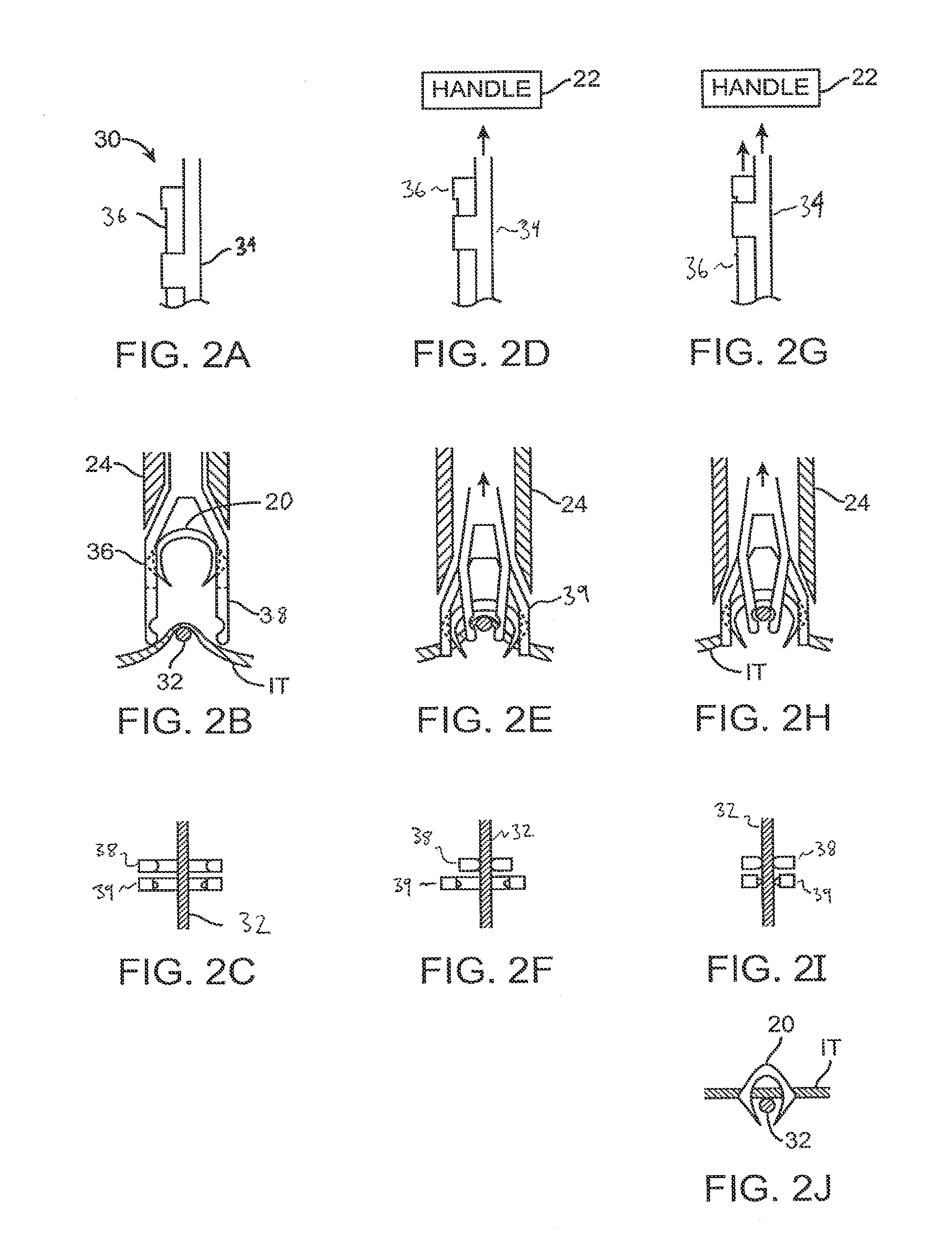Fasteners, deployment systems, and methods for ophthalmic tissue closure and fixation of ophthalmic prostheses and other uses
a technology of ophthalmic prostheses and ophthalmic tissue, applied in the field of medical devices, systems and methods, can solve the problems of difficult tissue suturing, high cost, and high time-consuming incision process
- Summary
- Abstract
- Description
- Claims
- Application Information
AI Technical Summary
Benefits of technology
Problems solved by technology
Method used
Image
Examples
exemplary embodiment 10
[0096]FIGS. 1A-1J illustrates an exemplary embodiment 10 of an apparatus (mechanism) for simultaneously grasping and clipping together the edges E1, E2 of tissue that have been wounded or incised. The apparatus 10 may include two sets of stacked shafts 12, 14, each with a distal jaw 16, 18. One shaft 12 and jaw 16 are designed to grasp and pull together the edges of the tissue E1, E2. The second shaft 14 and jaw 18 are designed to carry a normally open malleable clip 20 that may be compressed by the jaws 18 to form a closed clip 20 to secure the two edges E1, E2 of tissue together. The stacked shafts 12, 14 may be connected to a handle 22 that provides fore and aft axial movement of each of the jaws 16, 18 against an anvil 24 that surrounds the shafts 12, 14.
[0097]In operation of the exemplary embodiment in FIGS. 1A-1C, as the grasping shaft 12 is pulled by the handle, the jaws 16 of the grasping shaft 12 interfere with the anvil 24 and are compressed. Hooks or protrusions 26 at the...
exemplary embodiment 30
[0098]FIGS. 2A-2J illustrates an exemplary embodiment 30 of an apparatus for simultaneously grasping and clipping together prosthesis 32 to ophthalmic tissue. The embodiment illustrates, by example, the fixation of an intraocular lens haptic 32 (prosthesis) to iris tissue IT. The apparatus in FIGS. 2A-2J may include two sets of stacked shafts 34, 36, each with a distal jaw. One shaft 34 and jaw is designed to grasp and draw the tissue IT and prosthetic 32 toward the distal instrument. The second shaft 36 and jaw is designed to carry a normally open malleable clip 20 that can be compressed by the jaws to form a closed clip 20 to secure the intraocular lens haptic 32 to the iris IT. The stacked shafts 34, 36 may be connected to a handle 22 that provides fore and aft axial movement of the jaws against an anvil 24 that surrounds the shafts.
[0099]In operation of the exemplary embodiment in FIGS. 2A-2C, as the grasping shaft 34 is pulled by the handle 22 in operation, the jaws 38 of the g...
exemplary embodiment 40
[0100]FIGS. 3A and 3B illustrate an exemplary embodiment 40 of the apparatus in which the forceps 42 to apply the ophthalmic clip 20 may be positioned at an angle, on a plane, approximately tangent to the surface of the eye E and the clip 20 may be positioned approximately perpendicular to the tissue to be closed or fixated. The apparatus 40 includes forceps 42 may include jaws for securing a normally open malleable clip. In exemplary operation, when the handles 44 of the forceps 42 are squeezed together, the hinged forceps jaws 46 are drawn together, which close the malleable clip 20. A leaf spring 48 or other spring may be coupled to the handles 44 of the forceps 42 to keep the jaws 46 in a normally open position until the surgeon desires to deploy the clip 20. Once the clip 20 is deployed, the surgeon may release pressure on the handles 44 such that the spring returns the forceps 42 to the open position leaving the clip 20 in place on the tissue and allowing for removal of the fo...
PUM
 Login to View More
Login to View More Abstract
Description
Claims
Application Information
 Login to View More
Login to View More - R&D
- Intellectual Property
- Life Sciences
- Materials
- Tech Scout
- Unparalleled Data Quality
- Higher Quality Content
- 60% Fewer Hallucinations
Browse by: Latest US Patents, China's latest patents, Technical Efficacy Thesaurus, Application Domain, Technology Topic, Popular Technical Reports.
© 2025 PatSnap. All rights reserved.Legal|Privacy policy|Modern Slavery Act Transparency Statement|Sitemap|About US| Contact US: help@patsnap.com



